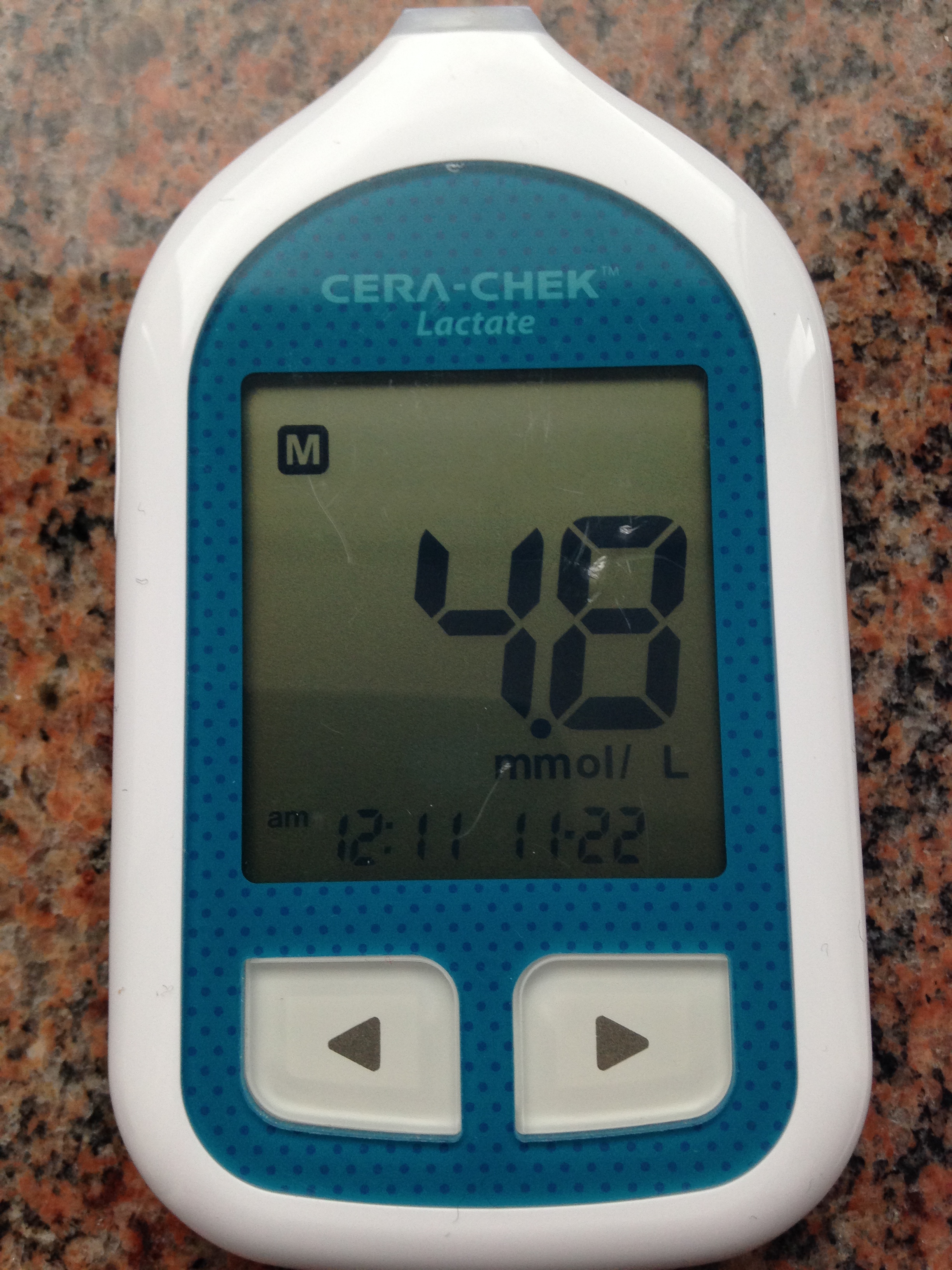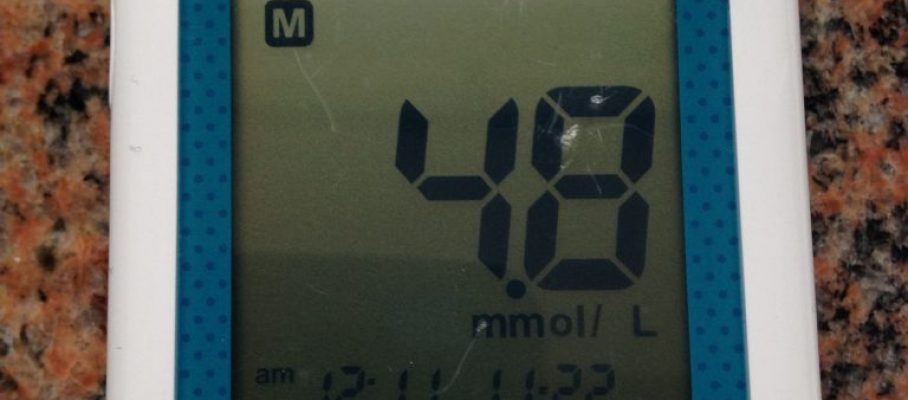Nov 22 2015
Preparing to measure Lactate
I have always been an interested reader of the Lactate based training discussion over at Free Spirits, but I have been hesitating a long time, because
- The devices and the strips used are expensive
- It’s just another biophysical marker that you can use. Granted, it is more direct than Heart Rate based training, but still there are external influences (ambient temperature etc) that make it hard to interpret a reading
Still, this sounds convincing:
Recently, I got a tip about a Polish distributor selling the Cera-Chek Lactate meter. It is sold on the Polish market for a very reasonable price and also the strips come at about half the price of the competitors. The Polish distributor was initially a bit reluctant to sell to the Czech Republic (hello single European market!), but in the end he agreed to sell.
The device arrived on Friday and yesterday I did my first successful measurement, a baseline measurement before exercise, quietly sitting down and taking time to do everything right. This practice made me actually quite nervous for the real testing during and immediately after rowing ergometer exercise, because it showed that some practice will be needed to get fast and accurate readings:
- I need to prick deep enough with the lancing device. I find it very hard to get even the tiniest amount of blood after the stab. Then one is supposed to wipe clean the finger and wait for the second drop. Milking the finger to speed up the process is said to distort the readings, but with the blood flow in my right hand fingers, it is really a question of minutes.
- You need to get enough blood sucked into the strip to do a reliable measurement. My understanding is that the strips have a chemical substance that reacts with the lactate and then the device just measures the current between two electrodes. The magnitude of the current is then converted to lactate concentration. What happens if there is not enough blood? Do you get an under-reading?
- You need to measure fast. On the Free Spirits Forum, I read that the pros do a measurement in 30 seconds. This includes a routing of finger drying, finger washing, finger drying, finger stabbing, droplet wiping, strip preparation, application of second droplet, and taking 10 seconds to get the reading. I would be lucky to do all this in two minutes … and of course the body continues to flush lactate from the muscles to the blood, then flush it from your blood. You have to be consistent to be able to compare measurements.
The test I wanted to do was the “long step test”. Basically you do 10 minute segments at increasing power, after which you measure blood lactate. You want to start a little below a power that gives 2.0 mmol/L, and end above it, so you determine the steady state power at which you train as close as possible to 2.0 mmol/L, which is believed to be most effective steady state training using a polarized training plan.
So what steps to use? I had a few clues of course:
- From my spiro tests I knew that my ventilatory threshold is about 234 W at 150 bpm.
- I have been fitting my season’s bests to a simple model using a “steady state” pace that I could sustain for hours and a limited “anaerobic” buffer that one empties during the test. A very crude model, but it is quite good in predicting paces on test pieces (just like the old “double the distance, add 5 seconds of pace). This model gave me 211 W as the steady state pace. Suppose this would be equal to my Maximal Lactate Steady State, than this would correspond to a blood lactate level between 3 and 4 mmol/L, which is also the recommended “intensive steady state” level recommended by many authors.
- My 2k SB is between 90-95% of Greg Smith (Quantified Rowing) in terms of Watts. He devised this test and runs it between 175W and 210W using 5W increments.
Difficult to decide. Starting at 160W and using 5W increments would bring me to 195W in 5 steps. That would probably be enough, but what if I hit 2.0 mmol/L already in the first step? Or if I wouldn’t hit it at all?
Here is what I decided to do:
Row 10 minutes at 160W/165W/170W/175W, taking 2 minutes of rest to try and attempt a lactate reading. At 175W, I would do the following:
- If just below 2.0, take another 10 minutes at 180W, then
- If above 2.0 at 180W, continue with 10W increments
- If not above 2.0 at 180W, continue with 5W increments
- If above 2.0, do next 10 minute intervals at 185W/195W/205W/220W
Sounded like a good plan.
I will follow up with a blog post about how the test really went. I will also publish a separate review of the Cera-Chek later. Here is a little teaser:


Nov 22 2015
Learning to measure Lactate
If you haven’t done so, you should really read this post, me waffling on about the test protocol and other general theoretical preparations. This post is about what actually happened.
The ambient temperature in my rowing basement was 12 degrees C. There was good air flow (door open to outside where it was 3C), and the humidity was quite high.
Here is the row:
Workout Summary - Nov 22, 2015
--|Total|-Total-|--Avg--|-Avg-|Avg-|-Avg-|-Avg
--|Dist-|-Time--|-Pace--|Watts|SPM-|-HR--|-DPS
--|19433|80:00.0|02:03.5|185.8|22.5|151.0|10.8
Workout Details
#-|EDist|-Etime-|-SPace-|Watts|SPM-|AvgHR|DPS-|Comments
01|02308|10:00.0|02:10.0|159.4|20.7|138.7|11.1|Lactate Lo
02|04644|20:00.0|02:08.4|165.3|20.9|140.3|11.2|Lactate 0.8
03|07009|30:00.0|02:06.9|171.3|20.8|143.3|11.4|Lactate 1.2
04|09391|40:00.0|02:05.9|175.3|21.4|145.7|11.1|Lactate 1.2
05|11796|50:00.0|02:04.7|180.3|22.0|148.3|10.9|Lactate Lo/0.6
06|14251|60:00.0|02:02.2|191.7|22.6|153.2|10.9|Lactate 1.0
07|16760|70:00.0|01:59.6|204.8|24.2|159.9|10.4|Lactate 1.4
08|19433|80:00.0|01:52.2|247.6|27.7|171.1|09.7|Lactate 4.8
So now I have a blue pinky finger and a well perforated ring finger on my right hand, I am a little confused, and I am torn between a few explanations:
What next?
I will continue to measure in the coming weeks, probably after 20 minutes and 60 minutes on a 3x20min session. I hope to get more handy with the measurements, and at the same time to get some more data that would confirm the normal lactate levels for my body. I will probably do the next 3×20 session at 200W, slightly faster than I used to, to see what that brings me.
By sanderroosendaal • Uncategorized • 11 • Tags: concept2, erg, lactate, OTE, rowing, steady state, test, testing, training